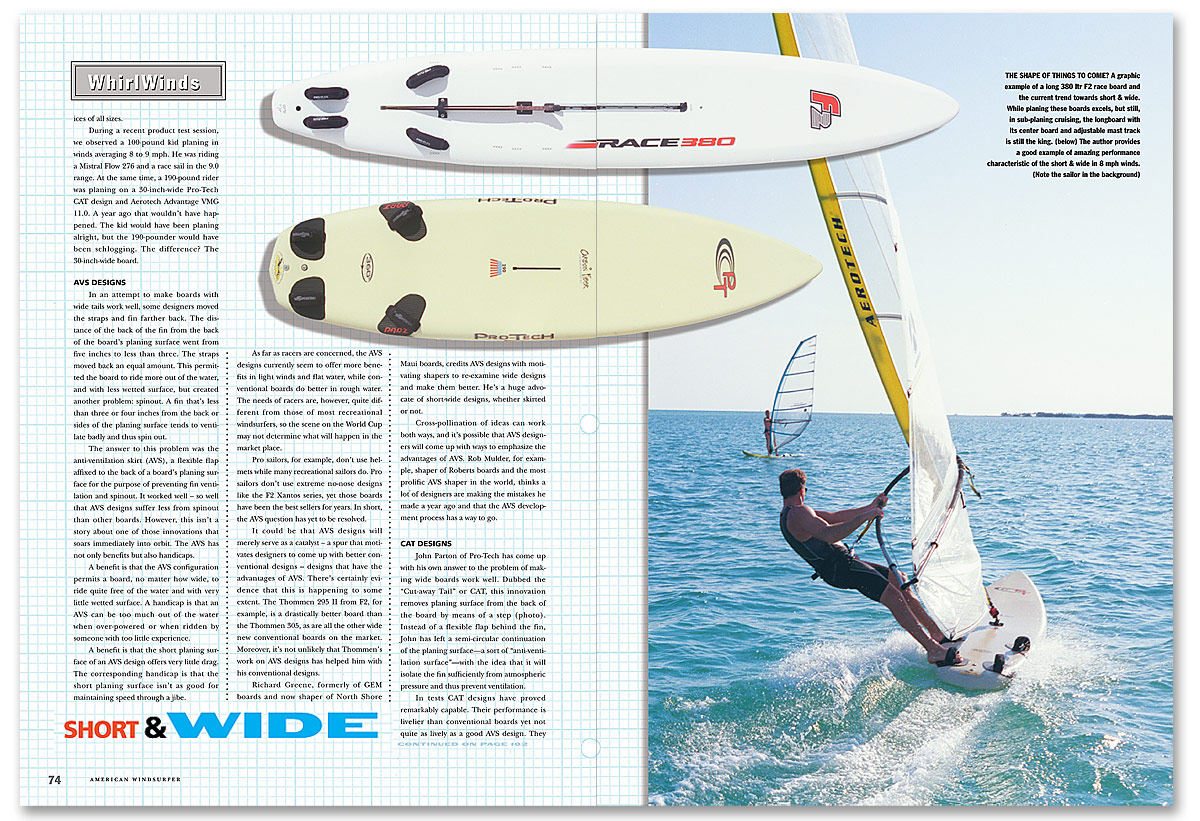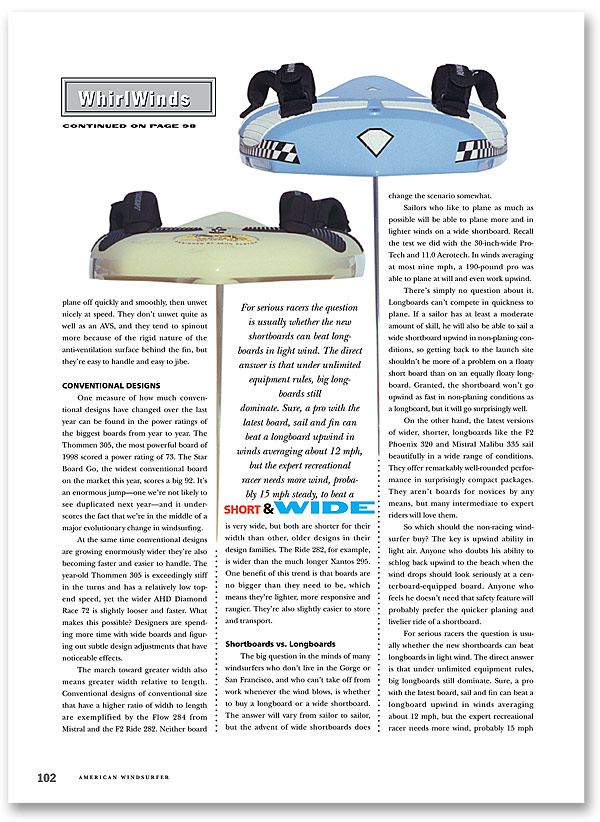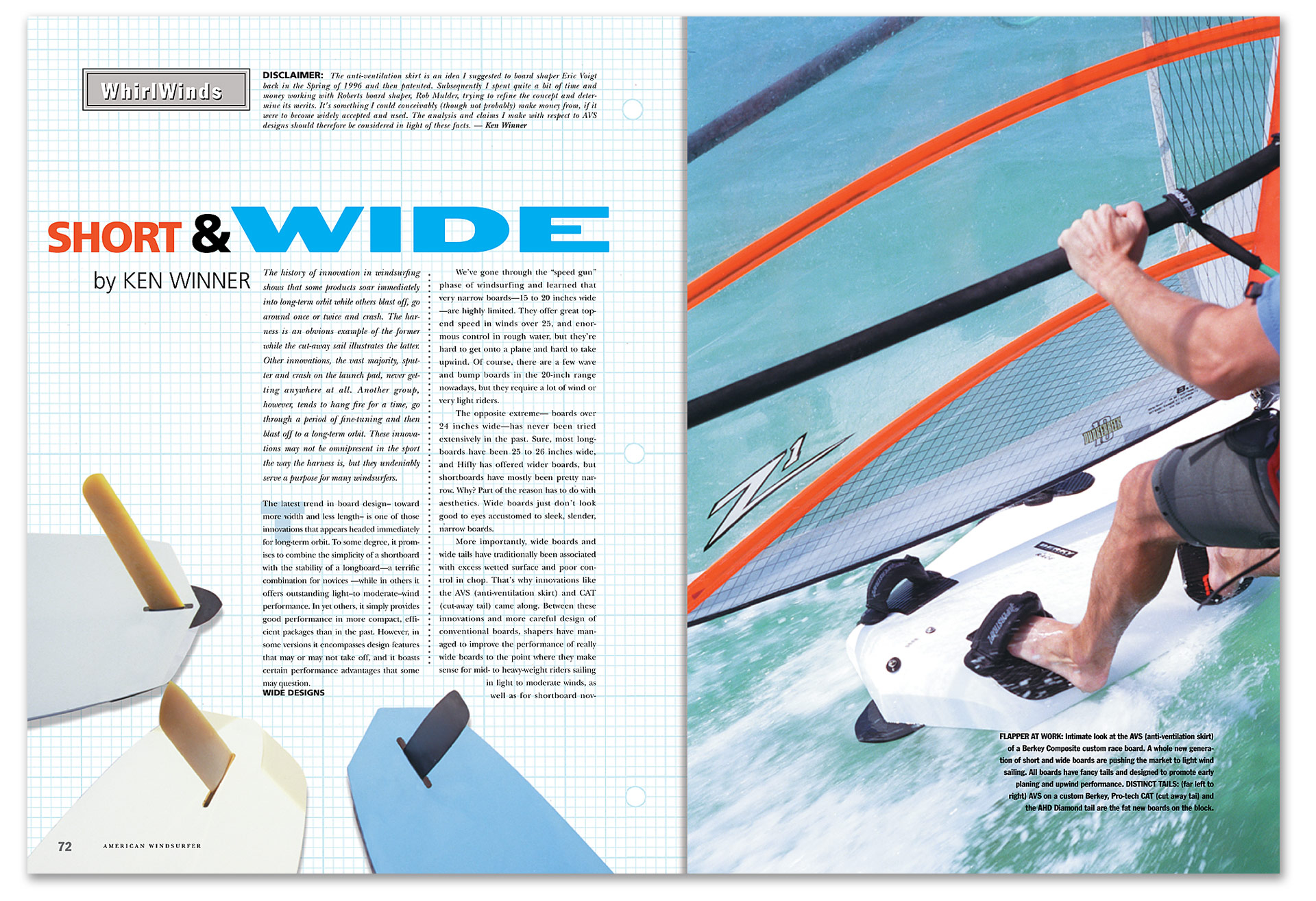FLAPPER AT WORK: Intimate look at the AVS (anti-ventilation skirt) of a Berkey Composite custom race board. A whole new generation of short and wide boards are pushing the market to light wind sailing. All boards have fancy tails and designed to promote early planing and upwind performance. Distinct tails: (far left to right) AVS on a custom Berkey, Pro-tech CAT (cut away tai) and the AHD Diamond tail are the fat new boards on the block.
Disclaimer: The anti-ventilation skirt is an idea I suggested to board shaper Eric Voigt back in the Spring of 1996 and then patented. Subsequently I spent quite a bit of time and money working with Roberts board shaper, Rob Mulder, trying to refine the concept and determine its merits. It’s something I could conceivably (though not probably) make money from, if it were to become widely accepted and used. The analysis and claims I make with respect to AVS designs should therefore be considered in light of these facts. — Ken Winner
THE LATEST TREND in board design– toward more width and less length– is one of those innovations that appears headed immediately for long-term orbit. To some degree, it promises to combine the simplicity of a shortboard with the stability of a longboard—a terrific combination for novices —while in others it offers outstanding light–to moderate–wind performance. In yet others, it simply provides good performance in more compact, efficient packages than in the past. However, in some versions it encompasses design features that may or may not take off, and it boasts certain performance advantages that some may question.
The history of innovation in windsurfing shows that some products soar immediately into long-term orbit while others blast off, go around once or twice and crash. The harness is an obvious example of the former while the cut-away sail illustrates the latter. Other innovations, the vast majority, sputter and crash on the launch pad, never getting anywhere at all. Another group, however, tends to hang fire for a time, go through a period of fine-tuning and then blast off to a long-term orbit. These innovations may not be omnipresent in the sport the way the harness is, but they undeniably serve a purpose for many windsurfers.
Wide Designs
We’ve gone through the “speed gun” phase of windsurfing and learned that very narrow boards—15 to 20 inches wide —are highly limited. They offer great top-end speed in winds over 25, and enormous control in rough water, but they’re hard to get onto a plane and hard to take upwind. Of course, there are a few wave and bump boards in the 20-inch range nowadays, but they require a lot of wind or very light riders.
The opposite extreme— boards over 24 inches wide—has never been tried extensively in the past. Sure, most longboards have been 25 to 26 inches wide, and Hifly has offered wider boards, but shortboards have mostly been pretty narrow. Why? Part of the reason has to do with aesthetics. Wide boards just don’t look good to eyes accustomed to sleek, slender, narrow boards.
Advertisement
More importantly, wide boards and wide tails have traditionally been associated with excess wetted surface and poor control in chop. That’s why innovations like the AVS (anti-ventilation skirt) and CAT (cut-away tail) came along. Between these innovations and more careful design of conventional boards, shapers have managed to improve the performance of really wide boards to the point where they make sense for mid- to heavy-weight riders sailing in light to moderate winds, as well as for shortboard novices of all sizes.
During a recent product test session, we observed a 100-pound kid planing in winds averaging 8 to 9 mph. He was riding a Mistral Flow 276 and a race sail in the 9.0 range. At the same time, a 190-pound rider was planing on a 30-inch-wide Pro-Tech CAT design and Aerotech Advantage VMG 11.0. A year ago that wouldn’t have happened. The kid would have been planing alright, but the 190-pounder would have been schlogging. The difference? The 30-inch-wide board.

THE SHAPE OF THINGS TO COME? A graphic example of a long 380 ltr F2 race board and the current trend towards short & wide. While planing these boards excels, but still, in sub-planing cruising, the longboard with its center board and adjustable mast track is still the king. (below) The author provides a good example of amazing performance characteristic of the short & wide in 8 mph winds. (Note the sailor in the background)
AVS Designs
In an attempt to make boards with wide tails work well, some designers moved the straps and fin farther back. The distance of the back of the fin from the back of the board’s planing surface went from five inches to less than three. The straps moved back an equal amount. This permitted the board to ride more out of the water, and with less wetted surface, but created another problem: spinout. A fin that’s less than three or four inches from the back or sides of the planing surface tends to ventilate badly and thus spin out.
The answer to this problem was the anti-ventilation skirt (AVS), a flexible flap affixed to the back of a board’s planing surface for the purpose of preventing fin ventilation and spinout. It worked well — so well that AVS designs suffer less from spinout than other boards. However, this isn’t a story about one of those innovations that soars immediately into orbit. The AVS has not only benefits but also handicaps.
A benefit is that the AVS configuration permits a board, no matter how wide, to ride quite free of the water and with very little wetted surface. A handicap is that an AVS can be too much out of the water when over-powered or when ridden by someone with too little experience.
A benefit is that the short planing surface of an AVS design offers very little drag. The corresponding handicap is that the short planing surface isn’t as good for maintaining speed through a jibe.
As far as racers are concerned, the AVS designs currently seem to offer more benefits in light winds and flat water, while conventional boards do better in rough water. The needs of racers are, however, quite different from those of most recreational windsurfers, so the scene on the World Cup may not determine what will happen in the market place.
Pro sailors, for example, don’t use helmets while many recreational sailors do. Pro sailors don’t use extreme no-nose designs like the F2 Xantos series, yet those boards have been the best sellers for years. In short, the AVS question has yet to be resolved.
It could be that AVS designs will merely serve as a catalyst — a spur that motivates designers to come up with better conventional designs — designs that have the advantages of AVS. There’s certainly evidence that this is happening to some extent. The Thommen 295 II from F2, for example, is a drastically better board than the Thommen 305, as are all the other wide new conventional boards on the market. Moreover, it’s not unlikely that Thommen’s work on AVS designs has helped him with his conventional designs.
Richard Greene, formerly of GEM boards and now shaper of North Shore Maui boards, credits AVS designs with motivating shapers to re-examine wide designs and make them better. He’s a huge advocate of short-wide designs, whether skirted or not.
Cross-pollination of ideas can work both ways, and it’s possible that AVS designers will come up with ways to emphasize the advantages of AVS. Rob Mulder, for example, shaper of Roberts boards and the most prolific AVS shaper in the world, thinks a lot of designers are making the mistakes he made a year ago and that the AVS development process has a way to go.

For serious racers the question is usually whether the new shortboards can beat longboards in light wind. The direct answer is that under unlimited equipment rules, big longboards still dominate. Sure, a pro with the latest board, sail and fin can beat a longboard upwind in winds averaging about 12 mph, but the expert recreational racer needs more wind, probably 15 mph steady, to beat a longboard.
CAT Designs
John Parton of Pro-Tech has come up with his own answer to the problem of making wide boards work well. Dubbed the “Cut-away Tail” or CAT, this innovation removes planing surface from the back of the board by means of a step (photo). Instead of a flexible flap behind the fin, John has left a semi-circular continuation of the planing surface—a sort of “anti-ventilation surface”—with the idea that it will isolate the fin sufficiently from atmospheric pressure and thus prevent ventilation.
In tests CAT designs have proved remarkably capable. Their performance is livelier than conventional boards yet not quite as lively as a good AVS design. They plane off quickly and smoothly, then unwet nicely at speed. They don’t unwet quite as well as an AVS, and they tend to spinout more because of the rigid nature of the anti-ventilation surface behind the fin, but they’re easy to handle and easy to jibe.
Conventional Designs
One measure of how much conventional designs have changed over the last year can be found in the power ratings of the biggest boards from year to year. The Thommen 305, the most powerful board of 1998 scored a power rating of 73. The Star Board Go, the widest conventional board on the market this year, scores a big 92. It’s an enormous jump—one we’re not likely to see duplicated next year—and it underscores the fact that we’re in the middle of a major evolutionary change in windsurfing.
At the same time conventional designs are growing enormously wider they’re also becoming faster and easier to handle. The year-old Thommen 305 is exceedingly stiff in the turns and has a relatively low top-end speed, yet the wider AHD Diamond Race 72 is slightly looser and faster. What makes this possible? Designers are spending more time with wide boards and figuring out subtle design adjustments that have noticeable effects.
The march toward greater width also means greater width relative to length. Conventional designs of conventional size that have a higher ratio of width to length are exemplified by the Flow 284 from Mistral and the F2 Ride 282. Neither board is very wide, but both are shorter for their width than other, older designs in their design families. The Ride 282, for example, is wider than the much longer Xantos 295. One benefit of this trend is that boards are no bigger than they need to be, which means they’re lighter, more responsive and rangier. They’re also slightly easier to store and transport.
Shortboards vs. Longboards
The big question in the minds of many windsurfers who don’t live in the Gorge or San Francisco, and who can’t take off from work whenever the wind blows, is whether to buy a longboard or a wide shortboard. The answer will vary from sailor to sailor, but the advent of wide shortboards does change the scenario somewhat.
Sailors who like to plane as much as possible will be able to plane more and in lighter winds on a wide shortboard. Recall the test we did with the 30-inch-wide Pro-Tech and 11.0 Aerotech. In winds averaging at most nine mph, a 190-pound pro was able to plane at will and even work upwind.
There’s simply no question about it. Longboards can’t compete in quickness to plane. If a sailor has at least a moderate amount of skill, he will also be able to sail a wide shortboard upwind in non-planing conditions, so getting back to the launch site shouldn’t be more of a problem on a floaty short board than on an equally floaty longboard. Granted, the shortboard won’t go upwind as fast in non-planing conditions as a longboard, but it will go surprisingly well.
On the other hand, the latest versions of wider, shorter, longboards like the F2 Phoenix 320 and Mistral Malibu 335 sail beautifully in a wide range of conditions. They offer remarkably well-rounded performance in surprisingly compact packages. They aren’t boards for novices by any means, but many intermediate to expert riders will love them.
So which should the non-racing windsurfer buy? The key is upwind ability in light air. Anyone who doubts his ability to schlog back upwind to the beach when the wind drops should look seriously at a centerboard-equipped board. Anyone who feels he doesn’t need that safety feature will probably prefer the quicker planing and livelier ride of a shortboard.
For serious racers the question is usually whether the new shortboards can beat longboards in light wind. The direct answer is that under unlimited equipment rules, big longboards still dominate. Sure, a pro with the latest board, sail and fin can beat a longboard upwind in winds averaging about 12 mph, but the expert recreational racer needs more wind, probably 15 mph steady, to beat a longboard.
Advertisement
Unfortunately, the question of whether a shortboard can beat a longboard ignores the fact that non-pro racing shouldn’t be primarily about having the fastest equipment money can buy. Instead, it should be about racing that’s affordable and equitable, which means limited-equipment or one-design racing. The Olympic class of longboards is affordable and equitable, as is the shortboard fleet of Bic Technos that Will Harper of Berkeley Windsurfing has started in the San Francisco area.
Granted, developing and tuning the latest and greatest equipment takes not only money but also great skill. It’s an absorbing mental discipline. But most recreational windsurfers lack the time and money for it and would be better off in limited-equipment fleets. Given this analysis, the question of whether longboards can beat shortboards is irrelevant. The proper question is what kind of board suits the wind conditions and sailors of a particular sailing area.
Summary
As we’ve pointed out before, hard-core windsurfers who freesail in winds solidly over 15 mph most of the time won’t be much affected by the trend toward short-wide boards. Some of the boards they can buy in 1999 may be a bit shorter or wider than similar boards from previous years, but these boards won’t differ radically in performance from boards sold in 1998.
Everyone, else, however, has a lot to look forward to. Racers can get more range out of a single board, novices can get shortboards that smooth the learning curve, intermediates will find the big wide boards are better platforms for learning to carve a jibe, and experts who love the sensation of planing but live in light-air places can look forward to more days on the water. Even the off-beat innovations—C.A.T. and AVS— that make big wide boards behave like smaller, more nimble boards have an important place in this scenario.
Bottom line: Short and wide is a trend not only for serious windsurfers but for everybody else as well.
Technical Editor Ken Winner is hard at work developing a short & WIDE intermediate board that is in the family of his popular WindGlider inflatable windsurfer.


